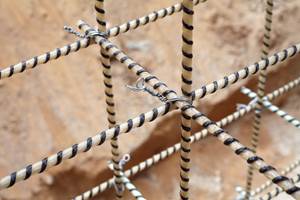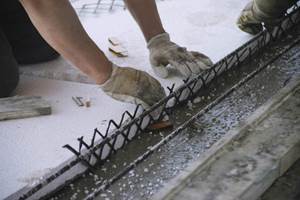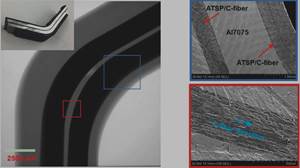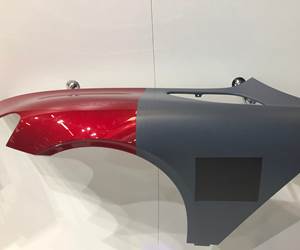New tornado panels made from composites
The UAB panels were approved by the National Storm Shelter Association to hold up against an EF5 tornado.

On my list of things I hate, tornadoes might be up at the top (along with cucumbers and scary movies). I’m originally from Oklahoma so I’m well familiar with tornadoes. Luckily, during my time there, I actually never saw a tornado in person, but many areas in that state have been devastated by that weather disaster.
So I read with great interest about a new solution that could potentially save lives during tornado storms. But this isn’t your typical storm shelter. These are tornado panels that are integrated into a room in an existing home or brought in as part of new construction.
Developed at the University of Alabama at Birmingham (UAB), the composition of thermoplastic and fiberglass resins and fibers used in the panels are stronger per-unit density than the steel used in many current shelters and weigh 80% less, according to the university. Some of the same foams and fibers are used in the latest armored military vehicles.
The research team developed a steel frame that holds the panels, and the frame can be broken down and carried into a closet or bathroom door and then reassembled. The panels, secured to each other and the floor of an interior room, protect against flying debris and are designed to keep people from being crushed or becoming airborne. The university says that the panels leave the assembly line looking like typical interior walls; they do not require paint and will never corrode.

Installing the tornado panels in the home. (Photo credit: UAB).
Uday Vaidya, professor and chair of UAB’s Department of Materials Science and Engineering, worked with Storm Resistant Systems and Cooper Structural Engineers to scale the prototype panels for use in a home. The safe room is designed in accordance with FEMA standards to withstand 250 mile-per-hour winds, and was built to remain intact even if the house were destroyed. This prototype is the first-of-its-kind, and it can be replicated for installation in other homes.
“With an average of more than 1,000 tornadoes recorded in the U.S. each year, it was crucial that something be done to make homes more safe,” Vaidya said. “Those tornadoes result in approximately 80 deaths and 1,500 injuries each year. Our goal was to develop new technology that would help protect individuals against the impact of debris during natural disasters, and I think with these panels, we’ve done just that.”
This installation comes after four years of research, testing, approvals and manufacturing, following the 2011 Alabama tornado outbreak. Following the devastation of those storms, Vaidya and his team of UAB engineers focused their attention on the development of a material that could transform any room into a safe haven. “2011 happened, and the work we were doing, we saw had a lot of applications for tornado-related activities,” Vaidya said. “During a tornado or hurricane, you get a lot of two-by-fours flying in a home; a lot of debris is picked up, and it can actually penetrate inside a house. People die from the debris that comes through the walls or other things, so we built panels that would resist the debris completely.”
Made from discarded liner once used to wrap offshore oil-rig pipes, the panels also embrace green engineering techniques. Recycled materials used in the experimental phase kept thousands of pounds of waste from landfills.
“The UAB panels are unique in comparison to the other products I’ve seen used in that they are lightweight, similar to plywood, but they have the strength equivalent to steel,” said David Cooper, president of Cooper Structural Engineers. “The ease of getting them in and out of a home for installation combined with the strength is what makes these panels a step above other products on the market.”
Moving forward, UAB will work with contractors and engineers seeking to integrate the panels into new construction as well as make them available to individuals who would like to purchase the panels to be retrofitted into existing homes.
It sounds like a great innovation that could save a lot of lives. Hopefully my home state pays close attention to this one.
Here's a video about the panels:
For individuals and businesses interested in learning more about the panels, contact UAB’s Material Processing and Applications Development Center at mpad@uab.edu.
Related Content
New standard specification supports non-metallic FRP rebar
ASTM International standard D8505 enables further integration of FRP rebar into infrastructure applications.
Read MoreComposites-reinforced concrete for sustainable data center construction
Metromont’s C-GRID-reinforced insulated precast concrete’s high strength, durability, light weight and ease of installation improve data center performance, construction time and sustainability.
Read MoreNew polymer expands composites options in demanding environments
Aromatic thermosetting copolyester offers unique properties, availability in multiple form factors.
Read MoreThe state of recycled carbon fiber
As the need for carbon fiber rises, can recycling fill the gap?
Read MoreRead Next
VIDEO: High-rate composites production for aerospace
Westlake Epoxy’s process on display at CAMX 2024 reduces cycle time from hours to just 15 minutes.
Read MoreCFRP planing head: 50% less mass, 1.5 times faster rotation
Novel, modular design minimizes weight for high-precision cutting tools with faster production speeds.
Read MoreModeling and characterization of crushable composite structures
How the predictive tool “CZone” is applied to simulate the axial crushing response of composites, providing valuable insights into their use for motorsport applications.
Read More













.jpg;maxWidth=300;quality=90)












